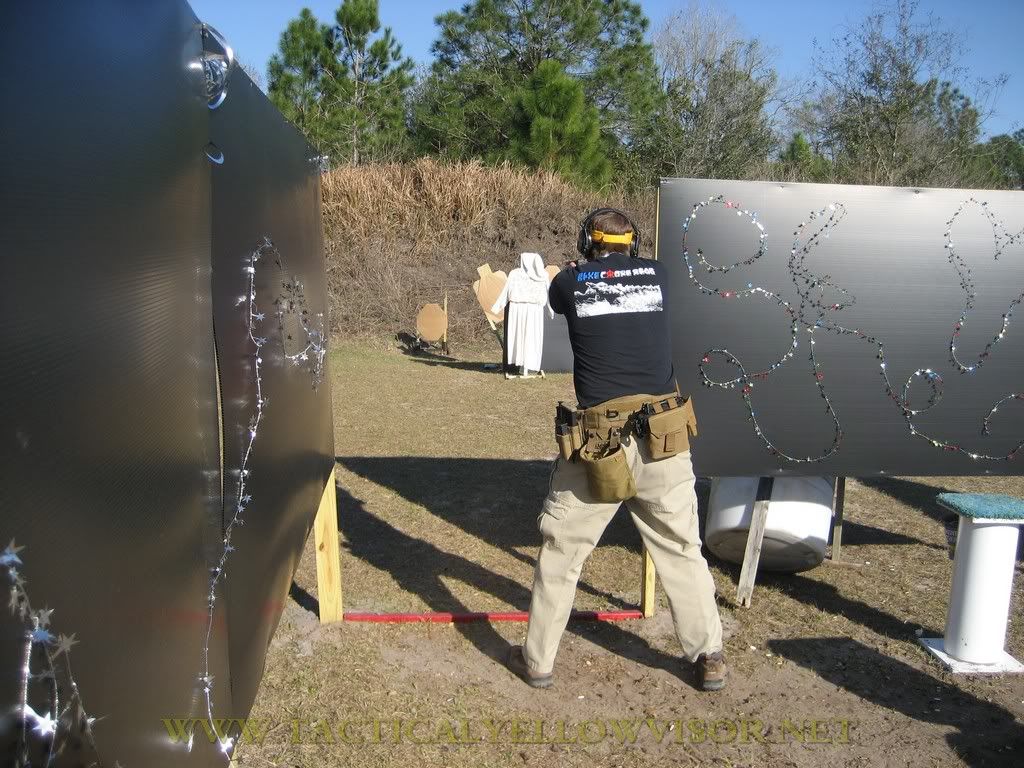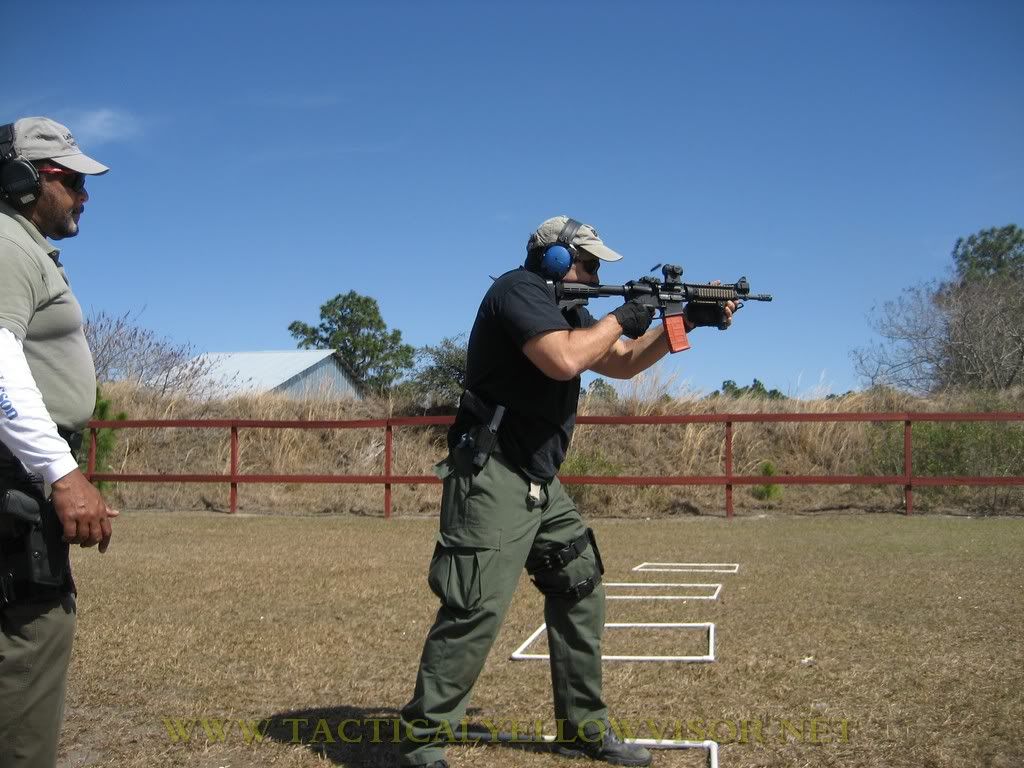Full AAR with all pics etc. can be found at this link. What follows below is all of the text and select photographs from the link above.
After Action Report:
00305-07 Universal Tactical Academy
3-Day Pistol/Carbine Operator High Performance Shooting Course
by Rob S of www.TACTICALYELLOWVISOR.net
Beginning on 5 March and ending on 7 March 2010 I attended a 3 day Pistol/Carbine Operator High Performance Shooting Course at the Universal Tactical Academy (AKA the Universal Shooting Academy) with Frank Garcia. As it turned out due to a personal family issue Frank taught only the first day and days two and three were handled by one of his cadre of instructors, Roy Tyler. Course sign-up was handled through Grey Group Training.
Weather could not have been better with absolutely clear skies and temperatures beginning in the mid 40s and peaking around 60 on 5 March and beginning at 50 and peaking at nearly 70 on 7 March. Weather like this is why we live in Florida.
I believe it is important for any gear or training reviewer to establish their prior experience for the sake of the reader so that they may asses the reviewer's frame of reference and compare it to their own. My training background until this point was heavily rooted in the Gunsite tradition. I have trained in the past with Randy Cain of Cumberland Tactics (6 times), Pat Rogers of EAG Tactical (4 times), Bill Jeans of Morrigan Consulting (2 times), and Louis Awerbuck of Yavapai Firearms Academy (once) all of whom have roots to one degree or another in Gunsite and all of whom have instructed there in the past. I have also trained with Travis Haley, Eric Torres and Chris Costa, now of Magpul Dynamics (once), which has been my only non-Gunsite-related trainer experience. The predominance of my training to this point (all of the above) has been at the Southern Exposure Training Facility. I say all of this to establish a background for myself as a frame of reference to other readers, and to point out that this class was a major departure for me on many levels. Comparisons to prior training are unavoidable and where they occur should not be taken as one being necessarily superior to the other on a macro scale. All instructors, and facilities, have areas where they excel, and I have learned valuable lessons from all of the above, and will return to train with all of them again. After Action Reports for many of my prior classes can be found in the AAR section of my website and in print in various issues of SWAT Magazine.
Facility
The Universal Tactical Academy (UTA) is located at 4300 C.R. 630 East just outside of Frostproof, Florida. Frostproof is located approximately equal distance from Lake Wales to the north and Sebring to the South, both of which have many hotel and dining options and are approximately a 20-30 minute drive from the range. I chose to stay at the Green Gables Inn in Lake Wales, and if you call to make your reservation they have a special rate for UTA students. Dining was nearby and convenient with a broad range of choices from fast food, to sit-down chains, to the local steakhouse Manny's Chophouse (recommended! Get there early!).
The UTA facility itself consists of 10-11 competition bays to the south and east and four training bays near the west central part of the property. There is a large Butler-building style barn at the north. There are restrooms with running water and standard facilities, and each bay has it's own covered area as well as a central covered area near the four training bays. These training bays are where we spent the majority of our time and they consist of, from east to west, a steel range with pneumatically-controlled pepper-poppers and rifle-rated dueling trees, a standard bay with frames for attaching targets at fixed distance, a steel range consisting of four plate racks with 6 plates each, and the bay furthest to the west that has a cable for moving targets as well as a variety of steel plate targets and target stands that can be configured into various scenarios. Over the course of the three days we moved from bay to bay in these four as we worked on various skills, as well as made trips to the competition bays as needed.
UTA Facility Satellite Image
1) Training Bays, 2) Competition Bays, 3) Barn, 4) Restrooms, 5) Training Pavilion
Gear Used
I chose to keep things simple on this trip and used the same load-carriage system all three days, and the same firearms throughout. Unless specifically looking to evaluate a system and variants I believe that this is a best practice. I have attended courses where the students swap guns more often than they change their underwear and it always presents problems. My gear used was as follows:
Handgun:
Glock 19 with extreme grip reduction by Boresight Solutions & Surefire X200A Weaponlight (discontinued) attached
Carbine:
Colt 6933 with Magpul MOE Stock, grip, and handguards and Tactical Link Battery Assist Lever (BAL)
Handgun Magazines:
Factory Glock 19 and Glock 17
Carbine Magazines:
Magpul Pmag 30 and Emag 30 and Bravo Company USA with Magpul followers & Magpul Ranger Plates
Handgun Magazine Pouches:
Eagle Industries Double Pistol Mag Pouch, FB MOLLE
Carbine Magazine Pouches:
US Grunt Gear 4th Gen Single M4/Glock
Handgun Ammunition:
Wolf 115 grain for 1k rounds & balance a random mix of various brass-cased
Carbine Ammunition:
Wolf 75 grain for 300 rounds and Federal XM193 for balance
Belt:
US Grunt Gear Warhog Modular Belt
Holster:
Peters Custom Holsters Spada Tactical Holster
Multitool:
Leatherman PSTII (no longer in production)
Multitool Pouch:
Eagle PSI Pouch (custom order from Polite Society, Inc.)
Dump Pouch:
CSM Gear Mini Drop Pouch
Sling:
Blue Force Gear Vickers Combat Applications Sling modified for one-to-two-point use
Carbine Optic:
Aimpoint T-1 on Daniel Defense Mount




 Reply With Quote
Reply With Quote








Bookmarks